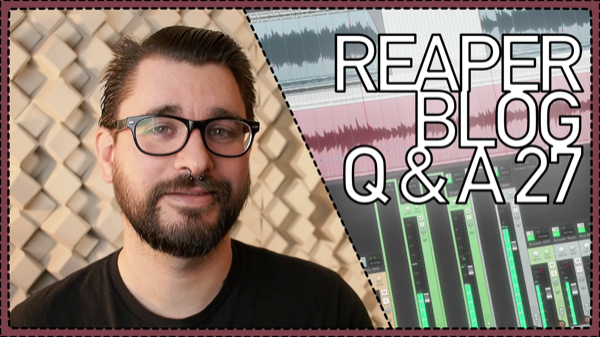Q&A Time again – in this round I’m answering your questions on : PT vs REAPER mix routing terms; best plugin format; mastering; Tom mixing tips; and How to present a portfolio of your work.
Huge thanks to everyone that has donated recently and to my Patrons.
00:28 – Q1: Pat A: In Pro Tools they always speak about the 2 bus, and the stereo bus, and the mix bus, and the print bus, etc.
What are the Reaper equivalents to these Pro Tools terms and approaches?
A – It’s basically the master track. Pro tools didn’t have faster than realtime rendering until recently so it was very common to route everything through an aux track (the mix bus) instead of the master, then record that to an audio track. A lot of Pro Tools mixers still like to work like this because they’re used to it. We really don’t need to work like that in reaper, unless we are going through hardware effects.
02:15 – Q2: Jeff A: is there a best format for plug-ins? VST 2, 3, or AU? Does Reaper process the AU the same way as it does VST?
03:22 – Q3: John C: I read recently that that you should first render your mix and then apply effects to the rendered wave file. I also read that if you have to apply equalising to your finished file, then you have somehow screwed up along the way and should listen again to the individual tracks in you’re original mix.
What’s your take on this?
Also any ideas on a good way to maximise without squashing song dynamics?
A – It’s totally normal to use EQ in mastering. When mastering you think about the song and listen to it in a different way. Use reference tracks whether mastering a single or album.
Try parallel compression to pump up quiet sections without flattening peaks. Automate volume for about 4dB difference between verse and chorus.
We go deep into mastering topics on The Mastering Show Podcast, try episode 22 for Why you shouldn’t master on your mix bus
05:31 – Q4: Jose: How do you approach to mixing toms that will cut through the mix?
A – I start with looking for the lowest frequency where they really resonate well, using a resonant Hi-pass filter.
Then I find low mid frequency that I can cut aggressively, which can often make them sound bigger.
Finally add a bit of a boost in the highs to emphasize stick attack.
For more attack use a transient shaper, possibly followed by a soft clipper.
See also video from Jordan V linked below
08:11 – Q5: Joshua: Tips on how to present a portfolio?
Show examples of your work, credits, and contact information.
Links:
The Mastering Show Podcast – http://themasteringshow.com
How to EQ Toms tutorial from Jordan V. Hardcore Music Studio – https://www.youtube.com/watch?v=Y3sz07OFrRI
ReelTalk game audio demo reel critique streams – https://www.twitch.tv/powerupaudio
http://www.twitter.com/reaperblog
http://www.facebook.com/thereaperblog
http://www.facebook.com/groups/reaperblogcommunity
http://www.patreon.com/thereaperblog


Comments
One response to “REAPER Blog Q&A #27 – VST2 3 or AU? Mixing Toms; Making a portfolio?”
Dear Sir, my Kontakt plugins or my Waves plugins are not showing up. I’m computer illiterate. Is there any help foe me.
I can’t afford it but I will Pay.
Reaper User